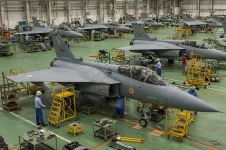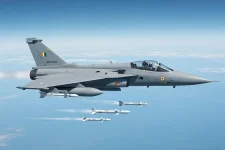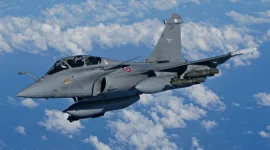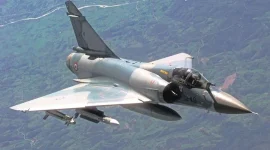
The Indian Air Force (IAF) is embarking on a modernization program for its Sepecat Jaguar deep penetration strike aircraft. The IAF, the world's sole remaining Jaguar operator, aims to integrate cutting-edge close combat missiles, significantly enhancing the aircraft's combat capabilities.
The IAF is seeking industry proposals to modify and equip two Jaguars with new-generation missiles. These missiles will integrate seamlessly with the aircraft's upgraded Display Attack Ranging Inertial Navigation-III (DARIN-III) avionics and a helmet-mounted display system (HMDS).
The HMDS is a pivotal upgrade, projecting flight and targeting data onto the pilot's visor for enhanced situational awareness. The IAF has identified the European-designed Advanced Short Range Air-to-Air Missile (ASRAAM) as the next-generation close combat missile (NGCCM) to replace the outdated Matra R550 Magic missiles.
ASRAAM features an advanced infrared (IR) homing system, allowing it to lock onto targets within sight at ranges exceeding 25 kilometers. Coupled with the HMDS, ASRAAM enables off-boresight targeting, meaning pilots can engage targets without directly pointing the aircraft towards them.
"These missiles, even without onboard radar input, make 'over-the-shoulder' shots possible. This, combined with the Helmet-mounted Sighting Display, gives pilots a significant advantage in close-range combat,” noted an official source familiar with the upgrade.
ASRAAM is a combat-proven missile in service with the Royal Air Force and Royal Australian Air Force. It has been successfully deployed on platforms like the Eurofighter Typhoon and F/A-18 Hornet, with ongoing integration efforts for the F-35 Lightning II.
The infrared, 'fire-and-forget' ASRAAM empowers Jaguars to counter various aerial threats, including fighter jets, transport aircraft, cruise missiles, and unmanned aerial vehicles (UAVs).
This integration project encompasses comprehensive technical work: studying existing DARIN-III avionics, developing new specifications, modifying software, airframe, and wing pylons, conducting flight trials, and ultimately, achieving final certification.
Background
The Anglo-French Sepecat Jaguar remains a cornerstone of the IAF's strike fleet. Of the 140 aircraft initially acquired, 125 remain in service. These Jaguars have seen action in conflicts like Operation Pawan in Sri Lanka and the Kargil War, primarily in reconnaissance roles. India is the last nation actively operating Jaguars, with a portion of its fleet adapted for nuclear delivery.The IAF has bolstered the Jaguars' capabilities through multiple upgrades, including the recent DARIN III, which features advanced avionics and mission systems.
However, the aircraft's engines remain a bottleneck, with plans to eventually replace the entire Jaguar fleet with the indigenously developed Light Combat Aircraft (LCA) Tejas Mk-2.




